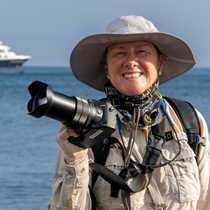The Steppes of Eastern Washington & Oregon
Just before dawn we sailed out of the The Dalles lock and left the dam behind. The clouds looked dark to the west, but overhead the blue of sky and wisps of cloud promised clear skies for our first day traveling east up the Colombia River. We had crossed through the coastal range overnight, leaving the rain in the Willamette Valley and had arrived in the dry channeled scablands of Eastern Washington and Oregon where not much rain falls most of the year.
After breakfast the John Day lock and dam had us all craning our necks as the Sea Bird passed under the massive 700 ton guillotine-style gate that dripped on us in a “brief shower” before the cavernous concrete walls of the lock embraced the ship in shadow. A deckhand threw the line around a floating bollard and the ship was made ready for the lift. The wind tunnel formed by the open gate lessened when the lockmaster “closed the door” and the chamber began to fill. It was a gentle movement as water flooded up from below and created eddies around us. As the highest vertical lift, this lock carried us up 105 feet (more than the Panama Canal in three stages!) in a half-hour. The warmth of the sun was a welcome feeling when the Sea Bird reached the top.
Today has set the stage for the rest of our expedition; historian Harry Fritz with the National Geographic Society introduced us to the Corps of Discovery, and geologist Richard Waitt with the American Association for the Advancement of Science and Sigma Xi explained the Missoula floods and their effect on the landscapes around us.
Western grebes, great blue herons, white pelicans;
Hell’s Gate, Umatilla, Blalock Islands;
Red Willow sangiovese, The Jack, Firehouse Red.
What do these all have in common? Us, today, on the Sea Bird, in the wake of Lewis and Clark.
Just before dawn we sailed out of the The Dalles lock and left the dam behind. The clouds looked dark to the west, but overhead the blue of sky and wisps of cloud promised clear skies for our first day traveling east up the Colombia River. We had crossed through the coastal range overnight, leaving the rain in the Willamette Valley and had arrived in the dry channeled scablands of Eastern Washington and Oregon where not much rain falls most of the year.
After breakfast the John Day lock and dam had us all craning our necks as the Sea Bird passed under the massive 700 ton guillotine-style gate that dripped on us in a “brief shower” before the cavernous concrete walls of the lock embraced the ship in shadow. A deckhand threw the line around a floating bollard and the ship was made ready for the lift. The wind tunnel formed by the open gate lessened when the lockmaster “closed the door” and the chamber began to fill. It was a gentle movement as water flooded up from below and created eddies around us. As the highest vertical lift, this lock carried us up 105 feet (more than the Panama Canal in three stages!) in a half-hour. The warmth of the sun was a welcome feeling when the Sea Bird reached the top.
Today has set the stage for the rest of our expedition; historian Harry Fritz with the National Geographic Society introduced us to the Corps of Discovery, and geologist Richard Waitt with the American Association for the Advancement of Science and Sigma Xi explained the Missoula floods and their effect on the landscapes around us.
Western grebes, great blue herons, white pelicans;
Hell’s Gate, Umatilla, Blalock Islands;
Red Willow sangiovese, The Jack, Firehouse Red.
What do these all have in common? Us, today, on the Sea Bird, in the wake of Lewis and Clark.




